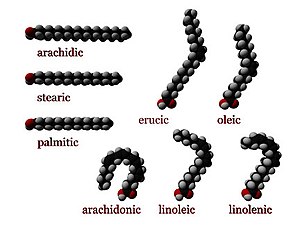Our website is made possible by displaying online advertisements to our visitors.
Please consider supporting us by disabling your ad blocker.
Fatty acid
| Types of fats in food |
|---|
| Components |
| Manufactured fats |

In chemistry, particularly in biochemistry, a fatty acid is a carboxylic acid with an aliphatic chain, which is either saturated or unsaturated. Most naturally occurring fatty acids have an unbranched chain of an even number of carbon atoms, from 4 to 28.[1] Fatty acids are a major component of the lipids (up to 70% by weight) in some species such as microalgae[2] but in some other organisms are not found in their standalone form, but instead exist as three main classes of esters: triglycerides, phospholipids, and cholesteryl esters. In any of these forms, fatty acids are both important dietary sources of fuel for animals and important structural components for cells.
- ^ Moss, G. P.; Smith, P. A. S.; Tavernier, D. (1997). "IUPAC Compendium of Chemical Terminology". Pure and Applied Chemistry. 67 (8–9). International Union of Pure and Applied Chemistry: 1307–1375. doi:10.1351/pac199567081307. S2CID 95004254. Retrieved 2007-10-31.
- ^ Chen, Lin (2012). "Biodiesel production from algae oil high in free fatty acids by two-step catalytic conversion". Bioresource Technology. 111: 208–214. Bibcode:2012BiTec.111..208C. doi:10.1016/j.biortech.2012.02.033. PMID 22401712.
Previous Page Next Page


